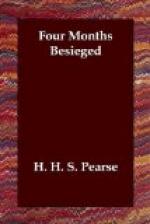their company leaders had all been hit, the Devons
straightened themselves for a charge. With bayonets
bristling they sprang to the crest, and their cheers
rang loud across the hills. A hail of bullets
made gaps in their ranks, but they closed up and pressed
forward, eagerly following their colonel. The
Boers, unable to withstand any longer the sight of
that fine front sweeping like fate upon them, fired
a few hundred shots and fled down hill, followed by
shots from the victorious Devons, who in a few minutes
more had cleared the position of every Boer.
That was the end of the fight, and though some enemies
still clung to Intombi’s crest waiting for darkness,
their fire soon slackened, and the hard-fought battle
ended in a complete defeat of the enemy at all points.
This brilliant victory, demonstrating to the Boers the vast difference between firing from cover on British assailants and attempts to storm positions held in force by our troops, cost the army at Lady smith 420 men in killed and wounded. The large proportion slain on the spot was remarkable, and was due, no doubt, to the close fighting. Fourteen officers were killed and 33 wounded, while the non-commissioned officers and men killed numbered 167, and the wounded 284. The killed included, besides Colonel Dick-Cunyngham, Major Mackworth of the 2nd Queen’s; Lieutenant Hall, Rifle Brigade; Major Miller-Wallnutt, Gordon Highlanders; Lieutenant Digby-Jones and Lieutenant Dennis of the Royal Engineers, all of whom met death heroically; Captains Lafone and Field, who were shot down as they charged at the head of their regiment; and many gallant volunteers serving in the ranks of the Imperial Light Horse. One company of the Gordons at the close of the battle was commanded by a lance-corporal, who was the senior officer unwounded. The Imperial Light Horse was commanded by a junior captain, and could only muster about 100 men fit for duty out of nearly 500. As to the Boer losses, it is difficult to arrive at the truth. The Boer has to be badly beaten before he will acknowledge having suffered a reverse, and even in such cases every endeavour is made to hide the real facts of the case, and the acknowledgment is tardily and reluctantly offered. As supplementing his description of the memorable struggle, we take the following extracts from Mr. Pearse’s diary:——
January 7.—I rode to-day over the battlefield, where dead Boers still lay unclaimed, but bearing on them cards that left no doubt about their identity. I learn that one of that brave little band, the Imperial Light Horse, wounded early in the fight, was tended gently by a Boer parson, who bound up his wounds and brought him water under a terrific fire. Struck by these acts of humanity and devotion to a high sense of duty, I made inquiries as to the Dutch parson’s name. It was Mr. Kestel, pastor of the Dutch Reformed Church at Harrismith, a Boer only by adoption, a Devonshire man by birth and descent.




